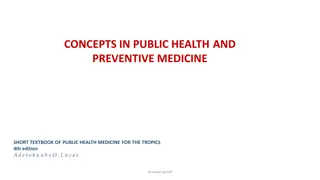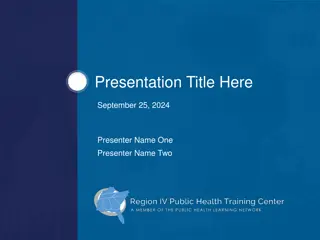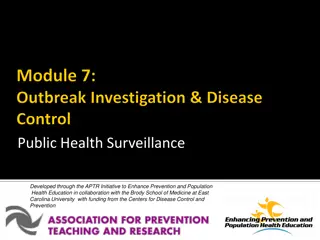Multidisciplinary Approach in Public Health Overview
This content presents essential concepts and principles of public health, emphasizing the integrative and multidisciplinary approach. It covers various components, goals, and development in public health, focusing on societal wellbeing and health promotion strategies. The importance of integrating multiple disciplines in public health programs is highlighted to maximize potential outcomes.
Download Presentation

Please find below an Image/Link to download the presentation.
The content on the website is provided AS IS for your information and personal use only. It may not be sold, licensed, or shared on other websites without obtaining consent from the author.If you encounter any issues during the download, it is possible that the publisher has removed the file from their server.
You are allowed to download the files provided on this website for personal or commercial use, subject to the condition that they are used lawfully. All files are the property of their respective owners.
The content on the website is provided AS IS for your information and personal use only. It may not be sold, licensed, or shared on other websites without obtaining consent from the author.
E N D
Presentation Transcript
1 SSRU.MPH/DrPH MPH5504-1 Multidisciplinary Approach in Public Health Dr. Thanawat Imsomboon, Dr. P.H.
2 SSRU.MPH/DrPH Course Description Concepts, principles, strategies, processes, and essential contents of public health related to definitive public health programs in terms of integration and other disciplines definitely important for public health work in multidisciplinary approach in different contexts of organizations to its maximized potentiality
3 SSRU.MPH/DrPH PART I : THE ESSENTIALS FOR PUBLIC HEALTH The philosophy of public heath Course Outlines The concept of public health The goals of public health Target of public health Social engineering in public health The principles of public health Public health development Determinants of health and diseases Components of public health Health state of various populations
PART II : INTEGRATIVE AND MULTIDISCIPLINARY APPROACH IN PUBLIC HEALTH 4 SSRU.MPH/DrPH Philosophy of multidisciplinary public health Concept of multidisciplinary public health Course Outlines Principle of public health integration Principle of multidisciplinary approach in public health PART III : THE ADVANCEMENT OF PUBLIC HEALTH DEVELOPMENT Public health components and their interrelationships Public health in general population Public health in age specific target group population Public health in special program or circumstance.
5 SSRU.MPH/DrPH Part I:Essentials for Public Health
6 PART I : THE ESSENCE OF PUBLIC HEALTH SSRU.MPH/DrPH What is Public Health Public health is the science and the art of organized societal efforts to ensure (and create) the conditions for the highest possible level of health and wellbeing of the population(s) consistent with the values of social justice and human rights. Public health is the science and art of preventing disease, prolonging life, and promoting all aspects of health and efficiency through organized community efforts. Charles Edward Amory Window, 1877-1957
SSRU.MPH/DrPH 7 Public Health Profile
8 SSRU.MPH/DrPH Philosophy of health is Prevention is Better Than Cure Philosophy of Health Health has been understood as the foundational good necessary for public life. Health is the values and traditions of communities and of relevant professions, providing an intellectual foundation for organized action to reduce suffering and promote well-being.
9 SSRU.MPH/DrPH Concept of public health Concepts of Public Health Health is really important to people and public health is essential to our individual and community well-being. It is the main part of improving people s lives everyday. Its strategies have been considered as the efforts to keep the whole community healthy. Public health for all specific populations will eventually promote necessary health, prevent susceptible diseases develop their resilience and foster optimum health from before birth till the secured death in life.
10 SSRU.MPH/DrPH According to the WHO, the goals of public health is to prevent disease, promoting health, and prolong life among populations as a whole. The Goals of Public Health Public health initiatives are aimed at fostering conditions in which people can be healthy within specific populations. To improve health outcomes of population through the achievement of objectives of preventing disease and the health consequence environmental hazards of natural or man-made disasters, promoting behaviors that reduce the risk of having poor health.
11 Principles of public health: Equity Social justice Participation Efficiency Effectiveness Acceptability Affordability Accessibility SSRU.MPH/DrPH The Principles of Public Health
12 SSRU.MPH/DrPH Equity in health implies that ideally everyone should have a fair opportunity to attain their full health potential access and maximal utilize the needed health services provided for all individuals in a society. Equity in Health Health equity requires removing obstacles to health such as poverty, discrimination, and their consequences, including powerlessness and lack of access to optimum health.
13 SSRU.MPH/DrPH Social Justice in Health Health justice give human dignity to everyone, regardless of who they are or where the come from. It means to equitable and affordable quality care for all.
14 SSRU.MPH/DrPH Population participation in health offers various advantages in health care and development among which are helping communities to develop health problem solving skills, making them to take responsibility for their health and well-being. Ensuring that the need for individual and community health are adequately addressed. Individuals come to know of the community health problems, and learn the ways and means of overcome these. Participation in Health
15 SSRU.MPH/DrPH Efficiency in Health Health efficiency is described as allocative efficiency means the best possible use of available resources for health care. Improving productivity in the quantity and quality of anticipated health outcomes with minimized reasonable resources indicate the efficient management of individuals and responsible organizations. In practical, efficiency refers to the attempt to peak the level of performance that uses the least amount of resource inputs to achieve the highest amount of health outputs.
16 SSRU.MPH/DrPH Effectiveness in Health Effectiveness known as efficacy is the capacity of a given intervention under ideal or controlled conditions. It is the ability to accomplish something with the least amount of time, money, human resource, and any other supportive facilities for the reasonable health outcomes. In other words, effectiveness of health performance is the degree to which health status is successful in producing desired results for optimum health.
17 SSRU.MPH/DrPH Acceptability is a multi-faceted construct that reflect the extent to which people delivering or receiving a healthcare intervention consider it to be appropriate, based on anticipated or experienced cognitive and emotional responses to the intervention. To determine how well an intervention will be received by the target population and the extent to which the new intervention or its impact might meet the need of target population and organizational setting. Acceptability in Health
18 SSRU.MPH/DrPH Affordability in Health Affordability affect healthcare in the way that lower income families spend a greater share of their income on health costs than those with higher incomes, and that health status of family members is associated with higher out- of-pocket expenses. Income is strongly associated with morbidity and mortality across the income distribution, and income- related health disparities appear to be growing over time. Income influences health and longevity through various clinical, social, behavioral, and environmental mechanisms.
19 SSRU.MPH/DrPH Accessibility in Health Accessibility can be defined as the case with which health services are reached in term of physical access, geographical distribution, cost, time, and availability of qualified personnel. Accessibility is a prerequisite for a high - quality and efficient system. Access to comprehensive, quality health care services is important for promoting and maintaining health, preventing and managing disease, reducing unnecessary disability and premature death, and achieving health equity for all population.
20 SSRU.MPH/DrPH Health development is the process of constant, progressive enhancement of the health status of population. Public health has developed over time to encompass a range of health issues, including poverty, environment, economics, epidemic, warfare, working condition, hygiene, health screening, immunization, personal lifestyles, and more latterly community and organizational development. An improved level of public health within a community directly enhance economic development. It becomes apparent that a lack of investment in public health adversely affects economic development Public Health Development
21 Components of public health program implementation: Innovation to develop the evidence-base for action. A technical package of a limited number of high-priority, evidence-based interventions that together will have a major impact. Effective performance management, especially through rigorous, real time monitoring, evaluation, and program improvement. Partnerships and coalitions with public and private-sector organizations. Communication of accurate and timely information to the health care community, decision makers, and the public to effect behavior change, and engage civil society. Political commitment to obtain resources and support for effective action. SSRU.MPH/DrPH Components of Public Health
22 SSRU.MPH/DrPH Determinants of Health Health is determined by multiple influential factors such as biological, environmental, social, economic, behavioral, etc. These factors are directly or indirectly determined our health status through the extent of its influence. So, we can improve our health status by managing and considering these determinants.
23 SSRU.MPH/DrPH Determinants of Health Factors influencing health are grouped in to: Biological determinants Environmental determinants Behavioral determinants Socioeconomic determinants Health services-related determinants Population-related determinants Biological Environmental Behavioral Socioeconomic Health service Population HEALTH
24 SSRU.MPH/DrPH Biological Factors as Health Determinants Biological factors can be all the individual characteristics of a person that have biological background, including genetics, family predisposition, pathology, health status anthropometry, body mass index (BMI)/adiposity, brain chemistry, hormone levels, nutritional status, birth weight, physical fitness levels, age, gender/sex, ethnicity, etc.
25 SSRU.MPH/DrPH Environmental Factors Having Impacts on Health Environmental factors are external influences that can affect an individual s health and well- being. Environmental pollutants can cause health problems like respiratory diseases, heart disease, and some types of cancer. People of low income are more likely to live in polluted areas and have unsafe drinking water. Children and pregnant women are at higher risk of health problems related to pollution.
26 SSRU.MPH/DrPH Environmental factors that affect health are: Chemical safety Air pollution Climate change Natural disasters Diseases caused by microbes Lack of access to health care Infrastructure issues Poor water quality Global environmental issues Environmental Factors as Health Determinants
SSRU.MPH/DrPH 27 Behavioral Factors as Determinants of Health The most important behavioral factors contributing to individual s health status are those health-related behaviors of persons, families, and communities for healthcare, disease prevention, health promotion, and prolonging life. Positive health behaviors are needed for health development, while negative health behaviors or behaviors that have bad influence to individual s health, family health, and community health are to be changed or modified to avoid such health problems.
28 SSRU.MPH/DrPH Behavioral Factors as Determinants of Health Many individual health behaviors affect a person s risk of developing a life-threatening diseases or infirmity. Any particular behavior or behavior pattern which strongly yet adversely affects health increases the chances of developing disease, disability, or syndrome. Examples of these factors include tobacco use, alcohol consumption, smoking, obesity, physical activity, sexual activity, narcotics use, malnutritional, certain risk behavior, etc.
SSRU.MPH/DrPH 29 Socioeconomic factors such as education, income, employment, housing, etc. can affect a person s health. Socioeconomic Factors as Determinants of Health People who are disadvantaged in one or more of these areas may have difficulty in taking health care or accessing health services and health service facilities, and this may in turn impact on their overall health and well-being. In general, people from poorer social or economic circumstance are at a greater risk of poor health, have higher rates of illness, disability and death, and live shorter live than those who are more advantaged. Every step up the socioeconomic ladder is accompanied by an increase in health.
SSRU.MPH/DrPH 30 Health Service Factors as Determinants of Health Health services that are factors contributing to heath are: Mental health care. Dental health care. Laboratory and diagnostic care. Substance abuse treatment. Preventative care. Physical and occupational health services. Nutritional supports. Foods and drugs services.
SSRU.MPH/DrPH 31 Population factors influencing health are: Population-Related Factors as Health Determinants The contribution on the disease incidence in a variety of population groups. The rapid population growth affecting access to health care and health care delivery. Rapid growing populations can increase pressure on resources, slow down the living standards, and degrade the social, environmental, and nutritional conditions. The rapid child bearing has an adverse effect on child survival.
32 SSRU.MPH/DrPH Population-Related Factors as Health Determinants Having children of low weight at birth can cause serious health problems for some babies. A baby who is very small at birth may have trouble eating, gaining weight and fighting off infections. Some may have long- term health problems, too. These changes cause population growth to end and population size stabilizes. Though the total population size is still high, but the low death rate and low birth rate balance each other, so that the population is no longer increasing. In this phase the birth rate falls to below replacement level.
SSRU.MPH/DrPH 33 Population- Related Factors as Health Determinants Effect of population decline on quality of life and economic development. It is the great burden of family members to take care of many aging population and money earning capacity, while the young population have markedly reduced in number, with increasing dependency ratio. The change of population pyramid cause more diseases and poor health conditions of aging population. The social and health services for aging population have to be tremendously increased under organized health and public services.
SSRU.MPH/DrPH 34 General socioeconomic, cultural, and environmental conditions Agriculture & foods production Education Work environment Living and working condition Unemployment Water and sanitation Healthcare services Housing Etc. Social and community networks Individual lifestyle factors Biological factors, such as genetics, age, sex, hereditary Determinants of Diseases
SSRU.MPH/DrPH 35 Determinants of health are the broad range of personal, social, economic, and environmental factors that determine individual and population health. They are: Heredity Education Economic Quality of environment Life events Healthcare Health related behaviors Social and community contexts Many more Determinants of Health
36 SSRU.MPH/DrPH Health status of a population can be measured by a wide range of factors; Health Status of Population Birth rate Death rate Life expectancy Quality of life Morbidity from specific diseases Risk factors Utilizations of health services and health facilities
SSRU.MPH/DrPH 37 Health State of Different Populations Pregnant woman Infant Preschool child School child and teenager Young adult Mature adult Aging
38 SSRU.MPH/DrPH Health care provided for expectant mother during her pregnancy. She will be prepared for birth delivery together with sufficient information and health literacy for caring of her pregnancy and her giving birth. Antenatal Care Difficulty and suffering of birth delivery has to be carefully advised to secure her confidence and practices on her motherhood especially in the case of first pregnancy.
39 SSRU.MPH/DrPH Perinatal care is the time before and after birth. Perinatal period is broadly defined by WHO in 1992 as the time frame from 22 complete weeks of gestation and end 7 completed days after birth. Death resulting from conditions that arise in the perinatal period can happen at any age. Perinatal deaths include those stillborn babies and those who are born alive but die before the end of the seventh day. This is the most critical point for consideration in pregnancy. Post Partum Care Perinatal Care
40 SSRU.MPH/DrPH Neonatal Care Neonatal care is the type of care a baby born premature or sick. When babies are born prematurely, their bodies may not be ready. Their heart, lungs, stomachs and skin may need help and support to survive.
41 SSRU.MPH/DrPH Puerperium period that needs postpartum care is defined as the immediate time from birth to 4 to 6 weeks after birth. The mother need to have the full assessment of physical, social, and psychological well-being, mood and emotional well-being, infant care and feeding, sexuality, contraception, and birth spacing. Postnatal care is standard for all mothers as new moms are at risk of serious and sometimes life treathening health complications in the days and weeks after giving birth. Postpartum/ Postnatal Care
42 SSRU.MPH/DrPH Preschool Children Preschoolers or a child aged 3 to 4 years are no longer toddlers that they are developing the basic life skills and health skills, independence, and knowledge that they will need as they enter their school years. They need ideal health promotion, disease prevention as well as accident or injuries preventions.
43 SSRU.MPH/DrPH School Children and the Youth School children and the youth need a healthy state mostly as the result of their good health practices. School health services are very important for them in terms of health promotion and disease prevention. The most significant one is the forming habits of drugs addiction, smoking, alcoholic consumption, risk behaviors conducing to injuries, and other poor health determinants.
44 SSRU.MPH/DrPH Adult population health is important almost through individual life, and as the life of parental age population responsible for the caring or nurture of their children s health, growth, and development in all aspects of health. Adult Population Meanwhile, in most cases, these population group have to take health care of their parents at the elderly age. Therefore health state of aging persons is primarily under care of the adult at home as well as at determined health facilities.
45 SSRU.MPH/DrPH The most common health problems of the elderly, composed of a variety of health problems, include physical, mental, and social health, and their capacities of living. The most difficult one is the pattern of elderly health care provision inside and outside the premises. The way that the government and families function, the ability of the government, communities, families to provide adequate resources for older adults, and the high prevalence of chronic diseases and disability. Aging Population
46 SSRU.MPH/DrPH Principle of Public Health Equity Fairness Inclusiveness Empowerment Effectiveness Evidence-based practice Details are as follows
47 SSRU.MPH/DrPH Equity of Public Health Health equity is the absence of systematic disparities in health between more or less disadvantaged social groups or different social determinants. It is created when individuals have the fair opportunity to reach their fullest health potential. Achieving health equity requires reducing unnecessary and avoidable difference that are unfair and unjust. Equity of public health will assure that everyone has the chance to be as healthy as possible.
48 SSRU.MPH/DrPH In public health we are concerned both with the overall well-being of populations, and with the degree to which that well-being is shared by groups within that populations. Fairness of Public Health Fairness includes the equity in health outcomes, in access to all forms of care and in a variety of public health resources. It also includes efficiency of management and allocation, since when resources are constrained their inefficient use means that some needs will not be met that could have been.
49 SSRU.MPH/DrPH Inclusiveness of Public Health The making of all groups of people feel included and valued within their society or community. Where individuals or groups of individuals are excluded, or feel on the margins of society there is often a direct impact on their health. Making healthcare inclusive come down to one simple concept respect. Treat each and every individual that walk to join public health program with the same respect. Take advantage of the opportunity to learn about a context or life experience different from your own.
50 SSRU.MPH/DrPH Effectiveness of Public Health Effectiveness of public health is measured from the following: The ability of monitoring health status. The capacity of diagnosis and investigation of health problems. The potentiality of informing, educating, and empowering people. The sufficient mobilization of community partnership. The continuous development of policies and plans. The regular enforcement of laws and regulations. The establishment of effective linkage of people to health services. The assurance of a competent workforce. The evaluation on effectiveness and quality of public health. Sufficient researches for new insights.























